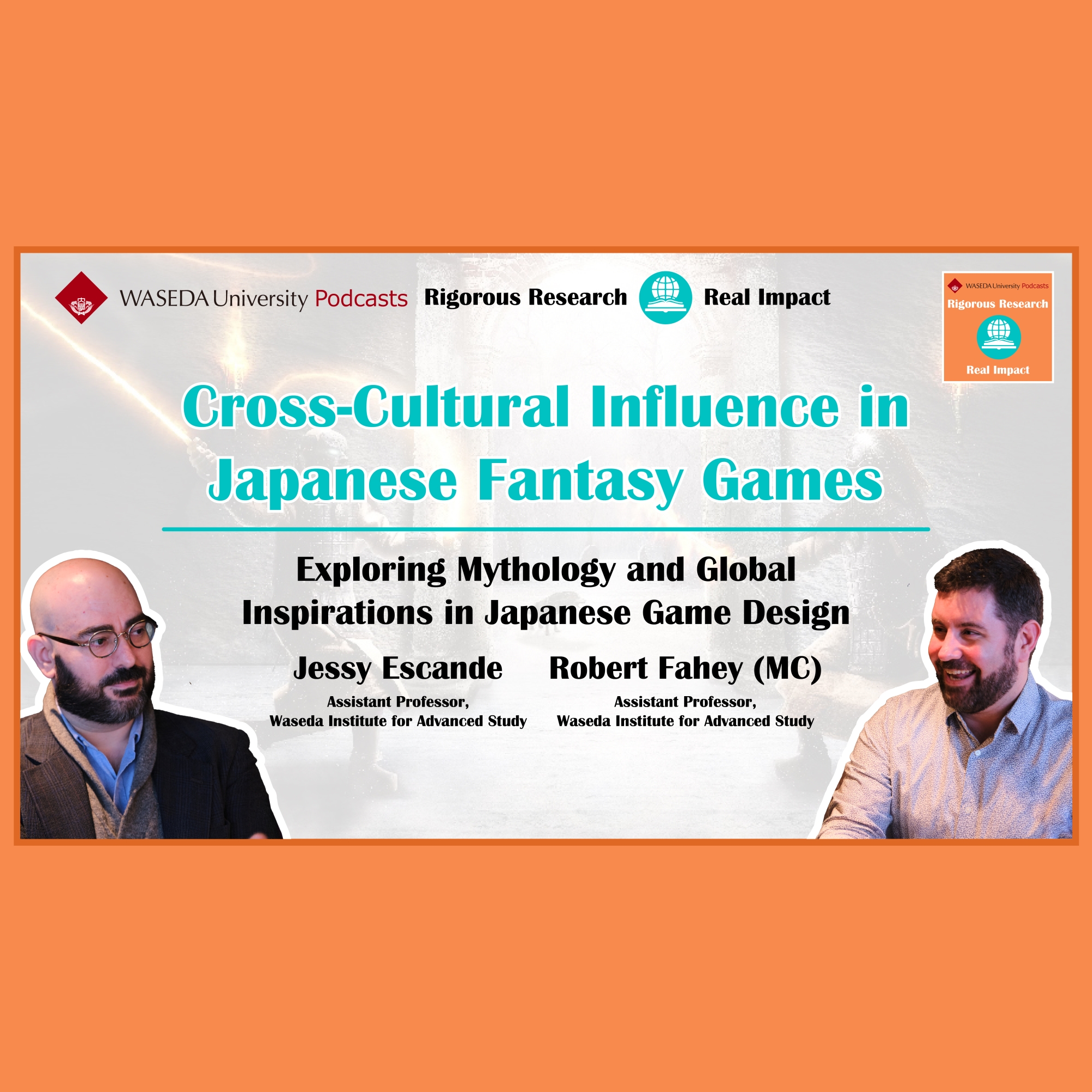【Waseda University Podcasts: Rigorous Research, Real Impact】“Cross-Cultural Influences in Japanese Fantasy Games”
Tue, Dec 17, 2024-
Tags
Waseda University released the fourth episode, “Cross-Cultural Influences in Japanese Fantasy Games”, of its English language podcast series “Rigorous Research, Real Impact” on December 17, 2024. All podcast episodes are available for free on Spotify, Apple Podcasts, Amazon Music, and YouTube.
Episode 4: “Cross-Cultural Influences in Japanese Fantasy Games”
Assistant Professor Jessy Escande (Waseda Institute for Advanced Study) converses with MC Assistant Professor Robert Fahey (Waseda Institute for Advanced Study) about the vital role that cultural transfer through “cultural ferrymen” such as J.L. Borges’ Book of Imaginary Beings has played in the development of a fantasy gaming tradition that is both uniquely Japanese and truly global. In this episode, Professor Escande shares his expert understanding of Japanese video games and their intricate ties to global folklore and mythology by elaborating on how mythical creatures like the Rakshasa, the Kujata, the Dullahan, and more made their way into popular culture in Japan.
“Waseda University Podcasts: Rigorous Research, Real Impact”
○Apple Podcasts
○Spotify
○Amazon Music
○YouTube
About the Series:
Waseda University’s first ever English-language academic podcast titled “Waseda University Podcasts: Rigorous Research, Real Impact” is an 8-episode series broadly showcasing the diverse work of our renowned social sciences and humanities researchers. In each of the short 15-30 minute episodes we welcome a knowledgeable researcher to casually converse with an MC about their recent, rigorously conducted research, the positive impact it has on society, and their thoughts on working in Japan at Waseda. It’s a perfect choice for listeners with a strong desire to learn, including current university students considering graduate school, researchers looking for their next collaborative project, or even those considering working for a university that stresses the importance of interdisciplinary approaches.
About the Guests
Assistant Professor Jessy Escande
Dr. Jessy Escande holds a PhD in comparative literature from Osaka University and is currently an Assistant Professor at the Waseda Institute for Advanced Study (WIAS). At WIAS his researches the reception of foreign cultures in Japanese fantasy works, and particularly the role of games as cultural brokers. Prior to taking his position at Waseda he served as a teaching fellow and researcher at Osaka University.
MC Assistant Professor Robert Fahey
Dr. Robert A. Fahey is an assistant professor of political science at the Waseda Institute for Advanced Study in Tokyo, Japan. His research interests include populism, polarisation, the effects of conspiracy theory belief, and Japanese politics. He is currently working on a series of large-scale surveys aimed at discovering what kinds of conspiracy beliefs are widespread in East Asian countries, and how those beliefs impact the political and social life of those nations.
Transcript
MC Professor Robert Fahey: Hello and welcome to Waseda University’s English podcast series titled “Rigorous Research, Real Impact”. In this series, we dive into interesting conversations and stories from Waseda’s vibrant academic and cultural community.
My name is Robert Fahey. I’m an Assistant professor of Political Science at the Waseda Institute for Advanced Study, and today I’m looking forward to speaking with Assistant Professor Jessy Escande, who is also from the Waseda Institute for Advanced Study. Dr. Escande holds a PhD in literature from Osaka University, and his research explores the reception of foreign culture in Japan through works of fantasy, including literature and video games.
His research interests include fantasy studies, game studies, genre studies, culture transfer theory, and media content theory, and he has published his work in journals, such as the Journal of Socioculture, Games and Culture, and Studies in Comparative Culture. In his work, Dr. Escande examines the vectors for culture transfer.
He points to the Japanese fantasy genre’s unprecedented rise in popularity over the past two decades and argues for more academic consideration of video games based on their role as agents for cultural transfers. In today’s conversation, we will be particularly discussing his article “Foreign Yet Familiar J.L. Borges’ Book of Imaginary Beings and Other Cultural Ferrymen in Japanese Fantasy Games.”
And we’ll talk about how Borges’ Book of Imaginary Beings and other cultural brokers have introduced foreign motifs into Japanese fantasy gaming. Welcome to the podcast.
MC Prof. Fahey (1:30~): Welcome to the podcast, Doctor Escande. Thank you so much for joining us today. To kick things off, could you tell us a bit about your background and what motivated you to focus on culture in your research?
Guest Professor Jessy Escande: So, to be honest, my main motivation was curiosity. In France during the 90s and early 2000s Japanese animation was on TV every morning.
Many of the games I played were Japanese role-playing games too. It was also in the late 90s that Japanese animation started to be recognized as cinema. So, a lot of the Japanese works I enjoyed were fantasy titles, and many of them were set in a kind of neomedievalistic Europe, not the historical Middle Ages, but fantasy worlds, making use of them as a groundwork and inspiration.
As a kid, I did not even realize that they were Japanese works. But as I grew older, I started wondering, why was Japanese fantasy so deeply rooted in foreign histories, myth and folklore? So that question became part of my PhD research. Such background pushed me to see culture not as something monolithic, specific to one country, but something more hybrid and complex.
Such richness is what pushed me to cultural studies, I think.
MC Prof. Fahey (2:50~): So, in your research work now, what would you say are the main areas that you focus on and what is it that you hope to achieve through your work?
Guest Prof. Escande: Since my work is quite transdisciplinary, it’s not easy to sum up. Broadly, I explore how foreign cultures are received in contemporary Japanese fantasy. Part of the answer lies in the role of foreign games, which became major cultural brokers in Japan during the 80s and 90s. They served as a new point of entry, or in some cases, re-entry for a wealth of cultural information that would go on to shape Japanese popular culture.
My PhD was actually in literature, but the uniquely Japanese fantasy genre I study, which I define as database fantasy, is more rooted in games than in literature. So, simultaneously, while I work to clarify the nature and mechanism of contemporary Japanese fantasy and the role that games play and continue to play within it, I also aim to highlight the significance of this genre and media for us as humans, beyond just escapism. As a species, we need fantasy, and it’s essential to explore such needs from a scholarly perspective. I just happen to focus on the Japanese case.
MC Prof. Fahey (4:10~): So, in terms of your focus on the Japanese case, it is drawing from other global fantasies and other global mythologies. What is it that makes the Japanese case specifically interesting within that realm to you at least?
Guest Prof. Escande: I wanted to understand why so much of Japanese fantasy draws not from local mythologies, as is often the case in other countries, but from foreign folklore, myth and legends. Simply attributing this to the introduction of such content into Japan, a kind of cultural history happenstance, is not a sufficient answer. It’s important to avoid framing this as a simple one-way relationship where Japan passively absorb external influences. That was not the case then, and it is still not the case now.
To better understand Japan’s active role in this cultural dynamic, I use the framework of cultural transfer theories spearheaded by French historian French historian Michel Espagne. The core of cultural transfer theory is its focus on transformation that occurs during cultural exchange and the key role of cultural brokers. Such brokers facilitate the crossing of cultural boundaries, but also add their own interpretation to the process.
They do not simply transport but transform. And such approach is especially relevant in understanding the development of contemporary Japanese fantasy and games as a wide-reaching nexus of transnational and transmedial influences deserved a particular attention.
MC Prof. Fahey (5:49~): You mentioned that a lot of Japanese fantasy works, whether it’s games or animation or literature, uses particularly European medieval type motifs. Can you talk, perhaps for those who are a little less familiar with those genres, about the sorts of motifs and the sorts of reception that they have received in Japanese fantasy work?
Guest Prof. Escande: So first, let’s clarify what we are talking when we say contemporary Japanese fantasy, which is a key word I will use a lot today. Where did it come from? What makes it different from earlier forms of Japanese fantasy? My focus is mostly on what I define as database fantasy. Not all Japanese fantasy falls into this category, but database fantasy exists only in Japan.
To put it simply, database fantasy is a genre or metagenre that encompasses many other genres and subgenre. Its defining feature is a vast database of motif, from standard settings to common storytelling tropes, and especially an extensive bestiary. It’s similar to what we call “genre fantasy” in the west, like sword and sorcery or heroic fantasy, where we expect certain elements: Heroes, dragons, adventurers, swords, wizards, essentially a recipe with specific ingredients. But while genre fantasy relies on such conventions, database fantasy works at a broader level. Unlike genre fantasy, it can be realized in countless ways.
Many instances do overlap with heroic fantasy, but the same motifs, like creatures drawn from foreign mythologies, also appear in works set in contemporary Japan, for example. So, database fantasy is different from earlier Japanese fantasy novels that were mostly directly inspired by Western literature. Database fantasy, on the contrary, is deeply rooted in the games introduced to Japan in the 80s.
So, coming back to your question, if we are discussing database fantasies and the cultural impact of foreign games as cultural brokers was enormous. Almost immediately, Japanese role-playing games became a space where such influences were absorbed and transformed. So, such antecedent influences, both from before and after such motif entered Japan are key to understand the richly hybrid imagination we find in contemporary Japanese fantasy.
MC Prof. Fahey (8:15~): When you say database fantasy, could you give a couple of practical examples perhaps of games or animations that people might have heard of that you would classify within that?
Guest Prof. Escande: Well, it’s honestly most of the popular Japanese fantasy nowadays. So, basically when we think of sword and sorcery type titles, an adventurer going into an adventure, stuff like maybe, if we want to be very stereotypical, a Dragon Quest or the recently very popular isekai genre, they all rely on the very same motifs. Like the medieval guilds. The adventurer guild is a common trope. It’s not about a specific work being unique, having a lot of idiosyncrasies. Of course they can have it, but Japanese creators rely nowadays a lot on a shared understanding of what will be that specific novel or manga and so on. So that whole database is what constitutes database fantasy.
MC Prof. Fahey (9:18~): In the paper we’re discussing today, you connect the work of J.L. Borges with Japanese fantasy games. Can you explain a little bit about J.L. Borges’ work and how it’s relevant in this context?
Guest Prof. Escande: Yes. So, in many of my case studies, I focused on specific motifs like the European goblin, the Jewish Golem, or the Arab ghoul. And I traced their cultural stories from their origins to their reinventions in Japan. In some cases, certain cultural brokers play a central role across multiple motifs, acting almost like floodgates in the flow of cultural transfer. They gather contents from various sources and channel it into Japan.
And one such broker is the Book of Imaginary Beings by Borges. This book is especially important because Borges himself consciously acted as a cultural broker, compiling mythologies from around the world and synthesizing them in one place. But when the Book of Imaginary Beings was translated into Japanese, its whole became more complex.
For all these reasons and more that I explore in my paper, Borges’ book serves as a unique cultural broker. And it absolutely deserved a focused study on its own.
MC Prof. Fahey (10:39~): So, in discussing how these cultural ferrymen and cultural brokers move motifs from folklore and mythology and religion, transferring it into Japan, transferring it into these mediums like games, can you give a brief overview of how you see that transfer process actually working?
Guest Prof. Escande: Fantasy worldbuilding has always drawn heavily from mythologies and reimagined histories. But games, starting with tabletop role-playing games and then video games, often reach further afield. For example, there was a show called Kolchak: The Night Stalker, which was on American television during ‘74, ‘75. It was a supernatural crime mystery with a “creature of the week” format.
In one episode, they featured the Rakshasa, a creature from Indian mythology. The show influenced the Dungeons and Dragons Bestiary, where the Rakshasa made its debut. And D& D bestiary, in turn, shaped early Japanese role-playing games.
So many Japanese iterations of the Rakshasa actually trace back to Kolchak by way of Dungeons and Dragons, despite India being a closer cultural sphere.
MC Prof. Fahey (11:53~): In the paper that we’re looking at today, you focus particularly on four motifs. You already mentioned the peryton. You also talk about the carbuncle, the catoblepas, and Kujata. Could you perhaps shed some light on the reasons why you chose those four motifs to look at specifically?
Guest Prof. Escande: All of these creatures share the context of Borges’ Book of Imaginary Beings, influenced by his choice in the information he included for each entry. Coming from a variety of cultural backgrounds, the carbuncle originates from Argentinian folklore. The catoblepas was a fantastical reimagination of the African gnu in ancient Roman natural history by people who had never seen a gnu. The peryton was a playful invention by Borges, and the Kujata is a mythical figure from Islamic cosmology.
These creatures entered Japanese fantasy as being of imaginary world settings for fictions, and not as mythological entities tied to specific real-world folklore.
So, there was a shift between Borges’ book and the uses made in Japanese video games. And if we look at why, it’s mostly because even though the Japanese translation of Borges’ book was read in Japan, a lot of its reception was secondary through its influence on Dungeons and Dragons and such a shift in understanding foreign motifs not as mythological beings but as fantasy creatures is well illustrated by a long running Japanese series of fantasy encyclopedias called Genso Sekai no Junintachi or Inhabitants of Fantasy Worlds.
The first volume by Takerube Nobuaki was published in 1988. And one fascinating aspect of this series and the cultural trends it reflects is the coexistence of an interest in the historical origins of such creatures alongside a tendency to unify them as beings of fantasy worlds, primarily in the context of role-playing video games.
MC Prof. Fahey (14:04~): When we talk about fantasy worlds in a Japanese context, one term that is unavoidable at the moment is isekai, which is a genre that has really been gaining enormous popularity. Can you briefly describe what that genre is and maybe talk a little bit about the societal implications of that and how it connects to your work?
Guest Prof. Escande: Yes. First, we can define isekai genre as a subgenre of database fantasy. So, when we think about the sociological implications of the fantasy genre, the isekai genre is indeed a prime example.
It’s not about depicting an isekai or “another world” narratively. The key point in isekai is that the protagonist is from our world, almost always a contemporary Japanese character. Such protagonist enters a secondary world usually inspired by the European Middle Ages and filled with creatures from various mythologies.
So yes, very much database fantasy, but essentially, it’s about the relationship between the protagonist and such Western like neomedievalistic world. So, what makes isekai unique and worth examining beyond its use of database fantasy database? When you take a broad view, it becomes clear that isekai reflects a dissatisfaction with contemporary Japanese society. Social frustrations and desires are embedded in the genre. The Japanese protagonist is often someone who’s been oppressed by society. They are often relieved to find a new world where they can succeed and self-actualize, which stands in sharp contrast to the struggles they faced in modern Japan which denied them self-actualization.
The subtext here is highly political, though it might not be parallel in its raw form.
Such representations, however, were made possible by the extensive database of motifs and settings that creators and audiences alike share an understanding of. In this way, isekai as a genre is very much a byproduct of database fantasy but exhibits a unique subtext.
MC Prof. Fahey (16:14~): In your research, you identify a number of cultural blind spots among creators. Could you talk a little bit about perhaps some examples of those blind spots and how they impact the representation of culture in games?
Guest Prof. Escande: Yes. I mostly focused on that aspect of foreign cultural reception in Japanese fantasy in my work on cultural appropriation. Cultural appropriation has taken on very negative connotations, but it originally had a more neutral meaning in anthropology, describing natural dynamics of cultural exchange.
I try to return to this neutral perspective while also recognizing that some forms of appropriation can be problematic, often when they are done ignorantly or mistakenly, even without harmful intentions. This is where the blind spots you mentioned become relevant. Blind spots operate along two main lines.
First, when these motifs are viewed solely as fantasy elements, they are often freely reimagined without much consideration for their original context. While this has fueled a rich Japanese fantasy imagination that is widely appreciated in the west, it can create blind spot about motifs, particularly those with religious significance.
The second axis of blind spots is the lack of understanding that religious elements in general may deserve such consideration, or at least recognition of their original cultural meaning. Such issues are tied more directly to how foreign motifs are absorbed into Japanese fantasy, like the golem. Before my own research on the golem, Professor Masahiko Date, an expert on Judaism and American literature, warned that the golem’s portrayal as an indiscriminately violent monster in Japanese role-playing games might be problematic given its traditional role as a protector of the Jewish people in related folklore.
MC Prof. Fahey (18:17~) : This brings me on to my next question, because I want to ask about the impact that globalization has had on creators in Japan. At some point, this Japanese fantasy was originally being created primarily for a Japanese audience. It’s now a very globalized genre and a globalized market. How has this shaped their creative processes? I mean, these blind spots you talk about are part of that. Are there other unique challenges and opportunities that they face in the world because of this interconnection and this globalization?
Guest Prof. Escande: So Japanese popular culture is now, in effect, global. We have widely recognized icons like Pokémon and Mario. But beyond that, Japanese popular culture has a deeper influence on Western media.
The challenge, though, is that many creators are still working with the mindset of the last century where foreign sensitivities were not a consideration, even when using foreign sources of inspiration. There is often little consideration for how Japanese titles might be received in countries from which they draw significant cultural references.
Part of the reason Japanese fantasy resonates so much in the west is that it presents an imaginary that would not be created locally. Adjusting Japanese content to align with foreign standards could risk stifling that uniqueness.
And beyond that, free creative expression is essential. But publishers as businesses may need to be more mindful about what they publish and where to prevent potential issues. The best cultural exchanges are based on mutual understanding, but unfortunately that’s not always the case now.
In my research, I describe a large portion of foreign cultural reception in Japanese fantasy as commodification of foreign cultures. So balancing respect for foreign sensitivities while preserving the richness of Japan’s cultural reinterpretations is not easy. Drawing a line between what is acceptable and what is not, what crosses ethical and economic considerations is very hard.
That’s also why I avoid making statements on what Japanese creators or publishers should do. It is not my place. What I can do in my work is providing scholarly insight that the Japanese entertainment industry can use to make informed choices.
MC Prof. Fahey (20:51~): I definitely agree that it would be a real shame if these problems had a chilling effect on the use of foreign motifs and foreign creatures and so on in Japanese fantasy. Speaking as an Irish person, I’ve always found it quite exciting to play a video game or to watch some fantasy movie or something and see that they’ve drawn something from Celtic mythology. That they’ve taken some creature or some character is always–there’s a little kind of thrill comes from that. Have you had those sorts of positive experiences as well? Or is that generally the experience you think people have?
Guest Prof. Escande: The problematic motifs reuses are a minority, but they cannot be just discarded because of that. However, yes, for most cases it’s actually quite welcome.
I do not have a specific personal experience because there is no very specifically French mythological creature used in Japanese fantasy. I am currently wrapping up a paper on a specific motif tied to it, the Irish Dullahan. Professor Masaya Shimokusu has published an English study focusing on the Dullahan.
So, the Dullahan is a fascinating case because it represents an exception to the usual pattern of Western game influencing Japanese fantasy. Unlike other motifs, it was not introduced or reintroduced to Japan through Western role-playing games. As Professor Shimokusu highlights, its introduction aligns more with the literary reception of William Butler Yeats.
And Yeats’ books from the late 19th century were translated into Japanese during the ‘70s, contributing to the Celtic boom. However, the Dullahan entered Japanese pop culture, its reimagining in games and wider media follows the same process as other motifs in database fantasy.
Originally a fairy death messenger, the Dullahan has become, in most cases in Japan, an undead monster. Often it is depicted as a woman or as a knight, and sometimes these three archetypes overlap. None of these interpretations align with the original Irish folklore and are unique Japanese reimaginations due to the influence of early Japanese video games.
MC Prof. Fahey (23:09~): I think with something like the Dullahan, for a lot of young Irish people, their first encounter with it is probably through a game like Final Fantasy or something. Because it’s not a particularly famous part of Celtic folklore. I would say there are probably far more Irish people who’ve encountered it through Japanese media than through William Butler Yeats. This globalization of culture, our own culture being reintroduced to us through Japanese video games is probably something very real.
Guest Prof. Escande: So, that does tie with what I underscored before, the fact that some motifs are actually more known by Japanese consumers than in their own original cultural area.
MC Prof. Fahey (23:48~): I wanted to talk briefly about something that we both have in common, which is being outsiders who are studying aspects of Japan. From your perspective, what are the advantages, both in terms of us as outsiders, you know, coming in and gaining these insights from Japan and from Japanese culture? But also, do we have perspectives that can perhaps offer a unique perspective on aspects of culture, cultural nuances that might be overlooked by local researchers?
Guest Prof. Escande: Observing something from the outside naturally provides a different perspective compared to viewing it from within. It does not necessarily mean this outside view is better or more objective, but it is distinct. And in a culturally homogeneous country like Japan, these different, less common perspectives can be valuable.
When the topic itself originates from outside Japan, but is internalized therein, like database fantasy, such external outlooks become even more relevant. I like to think I am making good use of my perspective as an outsider in my research. Japanese fantasy and its unique approach to internalizing foreign imaginaries is a good example.
This aspect is something many Japanese creators and consumers are not consciously aware of. For them, European-based neomedievalist fantasy is simply a given. That is what fantasy is.
My research started with the recognition that it is not, in fact, self-evident. Then I began exploring what makes Japanese fantasy unique, how it developed in this way, and why. This progression in my work was only possible because of my unique perspective, bypassing the usual blind spot regarding Japanese fantasy idiosyncrasies.
But it is also important to avoid the pitfall of one-to-one dualistic black-and-white comparisons. Comparative literature has certainly moved beyond these simplistic frameworks, yet it can be tempting to fall back on them, as they make analysis feel more manageable. On the contrary, I believe we should embrace complexity, even if it makes the work more challenging.
Balancing insider and outsider perspective is essential to negotiating these complexities, and international collaboration is invaluable here.
MC Prof. Fahey (26:16~): So, something else we have in common is that we both work at the Waseda Institute for Advanced Study. Can I ask you, how have you been finding it? I suppose technically you’re my kohai there. So how have you been finding the Waseda Institute for Advanced Study, and what sort of unique challenges and opportunities have you run into as a researcher here in Tokyo?
Guest Prof. Escande: The Institute is often described as a paradise for young researchers, and I could not agree more. We are granted immense freedom in our research, solid support, and very few educational or administrative responsibilities. We are encouraged to build our teaching experience and offered opportunities to do so, but only in a way that does not interfere with the primary focus on research.
And for me, WIAS is one of the very few places in Japan where my research can be conducted fully without having to adapt it to the restrictions of traditional departments, which sometimes operate within outdated major boundaries. As you can probably tell, my work spans multiple specialties and media as well as several cultural areas. While I do literary analysis, my research does not easily fit within a literature department.
In recent years, some Japanese universities have begun to incorporate video games into information or media studies, but the focus rarely touches on the cultural and literary aspects of the medium.
And, to be honest, working as a foreigner researcher on Japanese popular culture and teaching mainly Japanese students can be a bottleneck in more conservative institutions. In contrast, WIAS recognizes the value of diverse profiles and perspectives and imposes very few limitations.
The Institute is impressively international and multidisciplinary, which has been incredibly rewarding.
MC Prof. Fahey (28:08~): Dr. Escande, thank you again very much for being here with us today and for highlighting how literature transcends its original context, becoming relevant in these diverse cultural settings.
I think this conversation has really shown us the vital role that cultural transfer has played in the development of a fantasy literary tradition that is both uniquely Japanese and also truly global, and has really enriched our understanding of how Japanese video games are intricately tied to global folklore and mythology.
And to our listeners, thank you for tuning in. We hope this episode has sparked your interest in understanding the complexities of culture and the processes of cultural transfer. Dr. Escande’s insights into how folklore and mythological motifs are adapted in Japanese video games sheds important light on the ongoing evolution of cultural narratives.
For more such stories and insights from the corridors of Waseda University, don’t forget to subscribe and tune in to the next episode of “Rigorous Research, Real Impact”.
Until then, take care and stay curious.














